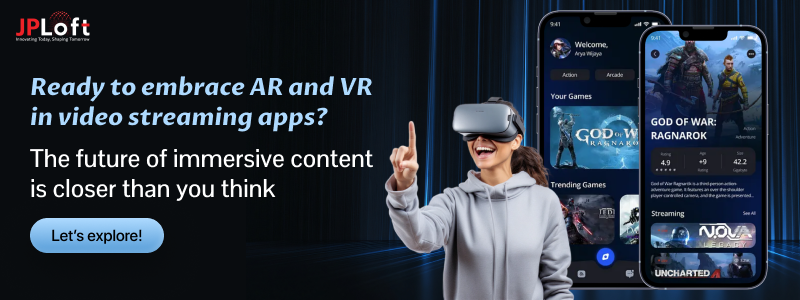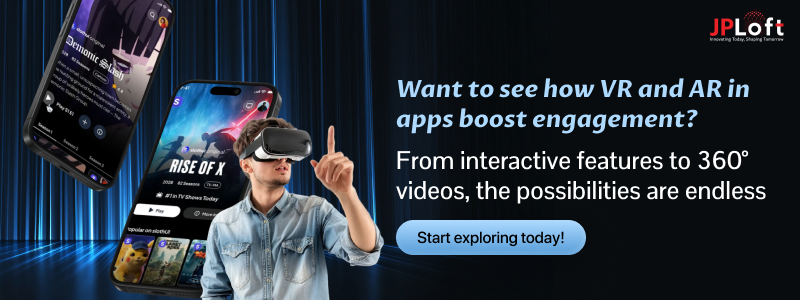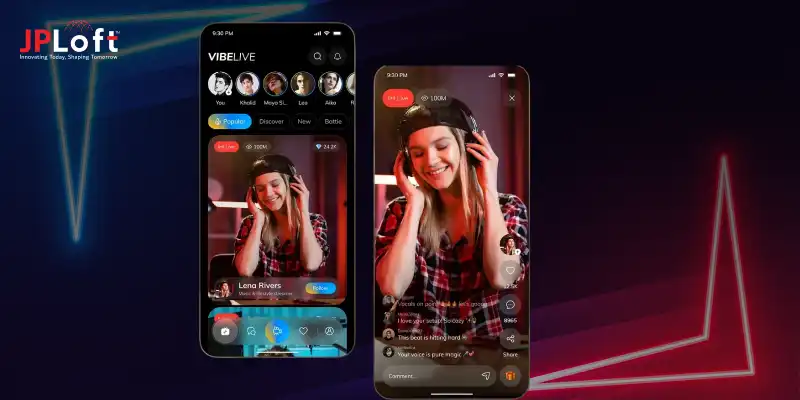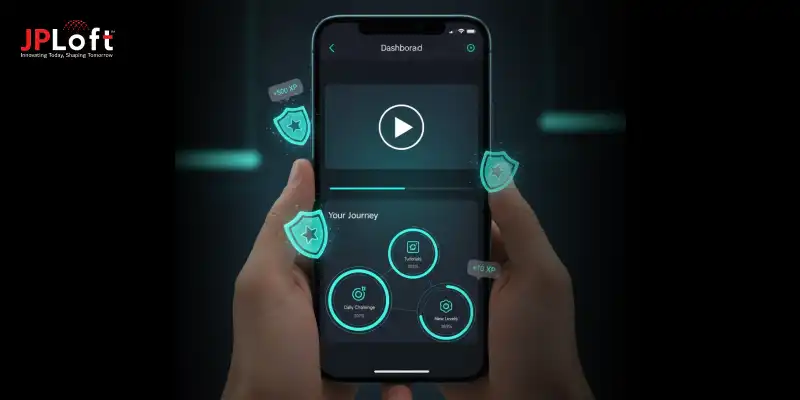Key Takeaways
AR and VR transform passive streaming into interactive, 360° experiences, making content engaging and unforgettable.
The AR/VR market is rapidly expanding, with mainstream adoption validating immersive video streaming as a future-ready industry.
AR/VR in video streaming apps boosts user retention, personalization, and interactivity, giving streaming platforms a competitive edge.
Premium VR events, AR ads, subscriptions, and micropayments unlock new revenue streams for businesses.
AI-driven personalization, cross-device integration, and blending physical-digital experiences will define next-generation video streaming apps.
Imagine putting on your headset and stepping into a live concert, a sports arena, or even into a movie scene from the comfort of your home. Seems unreal? But this isn’t science fiction anymore; it’s the power of VR and AR in video streaming apps.
The global video streaming market, projected to reach $330 billion by 2030, is rapidly shifting toward immersive video experiences that go beyond passive watching. With augmented and virtual reality in video streaming, users can enjoy 360-degree views, interactive storytelling, and a sense of presence like never before.
In the current scenario, where users are embracing technologies, AR and VR are much more than just futuristic buzzwords. Such tech is upgrading users’ experience and is opening new business ideas, revenue opportunities, as well as ways for brands to differentiate in the crowded market.
In this blog, we’ll explore how VR and AR are influencing the future of video streaming apps. From current trends and real-world applications to the technical foundations and monetization strategies, you’ll get a clear roadmap of what lies ahead. Also, how businesses can stay ahead by investing in interactive video streaming app development today.
What are AR and VR in Video Streaming Apps?
Imagine opening your favourite streaming app. Instead of just tapping play and watching a flat screen, you step inside the video itself.
With Virtual Reality (VR), you wear a headset and suddenly find yourself sitting in the front row of a concert or exploring a fantasy world as though you’re really there.
VR completely replaces your surroundings with a fully immersive video experience. Now, think of Augmented Reality (AR) as a bridge between your real world and digital elements.
Watching a cooking show? AR could project recipe steps right onto your kitchen counter. Streaming a live sports match? AR might overlay player stats in real time on your screen. Together, VR and AR in video streaming apps transform viewing into experiencing.
It makes content interactive, engaging, and unforgettable, opening endless opportunities for businesses looking to build a video streaming app with next-gen features.
Current AR & VR Industry Landscape
The VR/AR market is moving quickly from experimental to mainstream in the media and entertainment sector.
-
In the U.S. alone, revenues are projected to grow at a 10.72% CAGR, exceeding $20 billion by 2030.
-
Globally, immersive media is forecast to hit $75.9 billion by 2030.
-
Coupled with the rise of AR/VR headsets (a market forecasted to surpass $260 billion by 2034), the foundation for immersive streaming apps is stronger than ever.
Industry leaders are validating the trend of next-gen video streaming technology. Meta launched Horizon TV, a VR hub integrating Disney+, Hulu, ESPN, Prime Video, and more, alongside 3D concerts in Horizon Worlds.
YouTube added 8K VR streaming and co-watching features on Meta Quest. Netflix is testing immersive tie-ins like Squid Game Virtuals with Sandbox VR and building physical “Netflix House” venues for hybrid experiences.
Disney has explored AR storytelling through companion apps and is expanding streaming content into VR hubs.
Why Use AR/VR in Video Streaming?
As audiences demand richer, more dynamic ways to connect with content, VR & AR in video streaming apps are quickly becoming the future of entertainment.
These technologies don’t just enhance viewing; they transform it into immersive video experiences where users are part of the experience, not just passive watchers.
Here’s why integrating AR/VR into streaming platforms matters:
1] Immersive User Experiences
Traditional screens can’t match the depth of AR and VR. With next-gen video streaming technology, viewers enjoy 360° videos, 3D environments, and real-time overlays that make entertainment unforgettable.
2] Higher Engagement & Retention
Users are more likely to spend time on apps that offer interactive video streaming features such as live concerts, sports stats, or AR filters that personalize the experience.
3] Competitive Advantage for Businesses
For those planning to start an online video streaming business, adopting AR/VR early provides a major edge in standing out from traditional OTT platforms.
4] Future-Ready Streaming
The future of video streaming apps lies in personalization and interactivity, and AR/VR technologies ensure platforms are prepared for this evolving demand.
5] Revenue & Monetization Opportunities
AR/VR opens new revenue models like premium immersive content, virtual event tickets, and branded experiences, making it a valuable investment in OTT app development.
In short, AR and VR aren’t just trends; they are shaping the next-gen video streaming technology that defines how content will be created, delivered, and consumed.
How Does AR/VR in Video Streaming Apps Work?
Think about the last time you watched your favorite movie or a live match. Now imagine if, instead of just watching, you could step inside that world.
That’s exactly how VR and AR in video streaming apps change the game, by moving beyond passive screens into fully interactive video streaming experiences. But how does this technology actually work?
Here are the main tech components and architecture that can help you plan your video streaming app tech stack and make AR & VR in video streaming work.
1. Media Formats and Standards
VR and AR apps use special formats to make the video feel real. 360° and 180° videos let viewers look around in every direction. Stereoscopic video shows each eye a slightly different view, so scenes feel three-dimensional.
A newer format is volumetric video, which captures a whole scene in 3D, so users can move around inside it. Standards like MPEG-OMAF help these formats play well across different devices and ensure user engagement in streaming apps.
2. Streaming Protocols and Latency
Smooth streaming is key. Traditional methods like HLS and MPEG-DASH are common, but VR needs faster versions such as low-latency HLS.
For live events and shared viewing, WebRTC helps keep delays under control. To reduce lag further, many apps use edge computing, which processes data closer to the user instead of on distant servers.
3. Rendering and Device Support
People don’t all watch the same way. Some use phones for AR filters, others use VR headsets, and a few use powerful PCs for high-end graphics. Developers need to adjust video quality for each device.
Techniques like adaptive resolution and foveate rendering (focusing sharp detail only where the user is looking) save bandwidth while keeping the experience clear.
4. Edge, Cloud, and Content Delivery
VR and AR videos use much more data than a normal HD stream. To handle this, platforms rely on content delivery networks (CDNs) and cloud servers to send video faster across regions.
Many also use edge servers to share the work of rendering. This setup lowers the load on devices and makes playback smoother.
5. Sync and Real-Time Experience
Immersion depends on timing. Head turns, gestures, and group viewing all need to match what users see on screen. Even a tiny delay can break the effect.
Developers use time-stamped data and motion prediction to keep everything in sync so the experience feels natural and connected.
For entrepreneurs exploring top live streaming business ideas and embracing AR/VR means tapping into next-gen video streaming technology and offering audiences unforgettable, immersive journeys that traditional platforms can’t match.
Platform and UX Design Principles for Immersive Streaming Apps
A VR or AR streaming app is only as strong as the experience it gives the user. Even if the tech is powerful, poor design can make people feel lost or uncomfortable.
Hence, it is important to focus on key principles to design a video streaming app. Creating smooth, clear, and accessible user experiences is what helps people stay longer and return often.
► Navigation and Interface in 3D Spaces
Menus in VR or AR should feel natural. Instead of flat lists, apps often use floating panels, curved menus, or even interactive environments where content feels part of the scene.
The key is to keep it simple. A user should never feel like they are searching too hard for the “play” button. Easy navigation builds trust and comfort.
► Interaction Models
How users interact matters just as much as what they watch. Many apps allow gaze control, where a simple look at an icon selects it. Others support hand gestures, voice commands, or controllers.
The best approach is to offer flexibility. A person on a headset may prefer hand tracking, while someone on a mobile AR app may rely on touch. By supporting different modes, the app feels more natural and inclusive.
► Comfort and Accessibility
Comfort is critical. In VR, bad design can cause motion sickness or fatigue. Smooth frame rates, stable camera angles, and natural transitions help users enjoy content longer.
Accessibility matters too. Subtitles, multiple audio tracks, and adjustable font sizes make the app open to more people. Features like dark mode, audio descriptions, and simple onboarding tutorials can also create a more welcoming experience.
► Cross-Device Transitions
Most people do not own a VR headset. They may begin watching a show on a phone, switch to a TV, and later explore VR when possible. Apps that let users move smoothly between devices create better loyalty.
Imagine starting a concert stream on your phone, casting it to your TV, and later putting on a headset for an immersive front-row view. This type of flexibility matches how people actually consume content today.
Use Cases of VR and AR in Streaming Apps
When we think about AR and VR in video streaming apps, it’s not just about futuristic experiments; it’s about real, impactful applications that are already transforming the way we consume content.
From entertainment to education, these technologies are pushing the boundaries of what streaming can achieve. Let’s explore the most promising use cases:
1. Live Sports and Concerts in VR
One of the most exciting use cases is live streaming with VR. Imagine putting on a headset and finding yourself at the edge of a football pitch or in the front row of a concert, without ever leaving home.
VR video streaming apps make this possible, giving fans access to immersive video experiences that traditional broadcasts can’t match. For OTT platforms with VR and AR, this means higher user engagement in streaming apps and opportunities to sell premium virtual tickets.
2. AR-Powered Interactive Shows
With augmented reality in video streaming, entertainment goes from passive to interactive. Cooking shows can project recipe steps onto your kitchen counter, while travel documentaries can display 3D maps of destinations in your living room.
This is why modern video streaming app features are evolving to include AR overlays, making content educational, engaging, and practical at the same time.
3. Education and Virtual Classrooms
The role of VR and AR in video streaming apps extends far beyond entertainment. In education, VR can simulate historical events or scientific experiments, while AR can bring diagrams and visuals to life in real-world environments.
This makes online learning more immersive, accessible, and memorable. Schools, universities, and ed-tech companies are already experimenting with such models, adding tremendous value for students.
4. Corporate Training and Virtual Events
Businesses can leverage VR video streaming apps for employee training, offering simulations that replicate real-world tasks without risk.
Similarly, immersive entertainment apps powered by AR/VR can be used for virtual product launches, remote conferences, and networking events.
For companies aiming to design a video streaming app for internal or external purposes, AR/VR is a powerful differentiator.
5. Gaming and Esports Streaming
Gaming has always been at the forefront of innovation, and AR video streaming apps combined with VR are unlocking new ways to experience esports.
Fans can step into the game arena, switch perspectives, or even view player stats in real time.
For gamers, it’s the ultimate fusion of streaming and interactivity; for businesses, investing in the best video streaming apps is one of the considerable opportunities in the market.
6. Healthcare and Wellness
Another growing use case is in healthcare, where virtual reality in video streaming can help patients practice relaxation techniques, attend virtual therapy sessions, or experience guided meditation.
Fitness apps also use AR to overlay workout instructions in real environments, turning exercise into an engaging experience.
Business Models, Monetization & Go-to-Market Strategy
Building a VR or AR video app is not only about the tech. It’s also about finding ways to monetize a video streaming app and attract users.
Here are some of the most common models that work today.
A] Premium VR Ticketing & Pay-Per-View
Big events like concerts, sports games, or shows can sell virtual tickets. People pay once and feel like they are sitting in the front row without leaving home.
This is just like pay-per-view for boxing or wrestling, but in VR, it feels more real because you’re inside the event.
B] AR Overlay Ads, Product Placement & Shoppable Experiences
Ads in AR don’t need to pop up as banners. They can blend into the content. For example, in a cooking show, you could tap on the pan or knife the chef is using and buy it right away.
Or an ad can appear as part of the scene, making it less annoying and more useful. Brands like this model because it connects ads directly to shopping.
C] Subscription and Tiered Models
Most streaming apps use subscriptions, and VR/AR can fit right in.
A basic plan could cover normal shows and movies, while a premium tier adds VR concerts, AR extras, or exclusive angles for live events. This way, users who want more can pay more, while others still enjoy the regular content.
To successfully implement and scale such a tiered system, partnering with a specialized mobile app development company in Denver (or anywhere else with strong VR/AR expertise) would be important.
D] Hybrid Models and Micropayments
Some users don’t like paying every month. Hybrid models give them choices. They can keep a regular subscription but pay a small fee for extra features.
For example, a $2 charge might unlock a backstage VR view of a concert or a special AR filter. These small payments add up and give users control over what they spend.
E] Launch Strategy, Partnerships & Content Licensing
A great app also needs smart partners. Working with sports leagues, movie studios, or event organizers helps bring strong content from the start.
Deals with headset makers or mobile carriers can also spread the app to more people. Content licensing, where the app pays for rights to show videos, is another way to build a bigger library quickly.
Ethics, Challenges & Risks of AR & VR in Streaming Apps
VR and AR in streaming apps can be exciting, but there are also certain challenges in video streaming app development.
Being aware of these challenges can help you have a scalable app idea, developers can build better apps, and users have a safer experience.
1. Bandwidth, Latency & Infrastructure Costs
Immersive videos use much more data than regular streams. Watching a VR concert or 360° video requires fast internet. Slow connections can cause lag, freezing, or poor-quality visuals.
Solution: Apps must use content delivery networks (CDNs) and edge servers to bring videos closer to users. These solutions work, but they need careful planning and can increase the cost to develop a video streaming app.
2. Device Fragmentation & Hardware Limits
Not everyone has the same headset or AR-capable device. Some use mobile phones, some use standalone VR headsets, and some have high-end PCs.
Solution: Apps must work across different devices without lowering quality too much. This can be tricky and expensive.
3. User Comfort & Motion Sickness
VR apps can make users feel dizzy or tired if the visuals do not match their movements. Poor frame rates, fast camera moves, or abrupt transitions can cause motion sickness.
Solution: Developers must design smooth experiences and offer settings to adjust comfort levels.
4. Content Rights and Licensing
Streaming VR or AR content can raise legal questions. Developers must secure rights for videos, music, or 3D assets. Using unlicensed content can cause lawsuits.
Also, you need to be aware of the video streaming app compliances so that they can be taken care of from the initial app development process.
Solution: Apps should also manage geographic restrictions and copyright rules.
5. Development Cost and Timeline
Another key challenge is the lack of information regarding the time required to develop a video streaming app. Also, struggling with the cost of app development, budget planning, and allocation.
Solution: To resolve the lack of clarity on cost and time, begin with a brief discovery and planning Phase. This initial step yields a detailed project blueprint and a defined scope, enabling the development partner to provide a fixed-price budget and a reliable, phased timeline for the video streaming app's development.
6. Privacy, Data Safety & Ethics
VR and AR apps collect a lot of data, including head movements, gestures, and sometimes location. Companies need to protect this information. Clear privacy policies, secure storage, and user consent are essential.
Solution: Focus on ethical design, which also means avoiding features that manipulate or harm users, such as misleading ads or addictive mechanics.
Future Trends of VR and AR in Video Streaming Apps
The future of video streaming apps is set to be more immersive, interactive, and intelligent than ever before. As technology continues to evolve, VR and AR in video streaming apps will no longer be niche features; they will become mainstream expectations.
A] Smarter, AI-Driven Immersion
The role of AI in a video streaming app is already making waves by personalizing content recommendations and optimizing the video player as per viewer preferences.
With the rise of AR and VR in streaming apps, future platforms will use intelligent algorithms to personalize every aspect of viewing.
Whether it’s choosing the best camera angle in VR video streaming apps or overlaying real-time data in AR video streaming apps, AI will make content truly adaptive.
B] Seamless Integration with OTT Platforms
Expect OTT platforms with VR and AR to merge traditional video libraries with immersive video experiences, where users can jump between flat content and immersive entertainment apps without disruption.
This trend will reshape how users engage with live events, sports, and interactive shows.
C] Enhanced App Security
As immersive platforms grow, ensuring video streaming app security will become even more critical.
Protecting user data, in-app purchases, and AR/VR interactions will be central to maintaining trust. Platforms that integrate secure architectures into their tech stack will lead the way.
D] New Revenue Models and Monetization
Businesses will explore innovative ways to monetize a video streaming app. From exclusive VR concerts to interactive AR product placements, immersive platforms will open premium revenue streams.
Entrepreneurs aiming to create apps in this space will find countless opportunities to stand out with unique monetization models.
E] Blending Physical and Digital Worlds
In the coming years, live streaming with VR will let users experience global events without leaving home, while AR will enhance real-world surroundings with interactive storytelling.
This convergence will redefine trends, making them a central part of both entertainment and lifestyle.
The future of VR and AR in video streaming apps isn’t just about watching, it’s about living the experience.
If you are planning to create an app, be ready to innovate, secure your platforms, and embrace these next-gen video streaming technologies.
This will not only capture audience attention but also define the future of entertainment.
How JPLoft Can Help You Build Next-Gen Video Streaming Apps
Building a successful streaming platform requires more than just a sleek interface; it needs innovation, scalability, and security. JPLoft, a leading video streaming app development company, specializes in crafting next-gen apps powered by VR and AR technologies.
From integrating advanced features to ensuring seamless performance across devices, we deliver solutions tailored to your business goals. Whether you want an app for entertainment, education, or live events, the team ensures cutting-edge design, high-end security, and strong monetization models.
With expertise in tackling challenges such as latency, bandwidth, and compliance, we empower businesses to launch apps that engage users and stand out in the market.
Partnering with JPLoft means transforming your idea into a high-performing, future-ready streaming solution.
Final Wrap-Up
The demand for immersive content is growing, and technologies like VR and AR are reshaping how audiences connect with media. From live concerts and sports to education and healthcare, the use cases of VR and AR apps are limitless. Businesses that adapt to these innovations early will gain a clear competitive advantage.
However, success depends on understanding app features, tackling technical hurdles, and implementing secure monetization models. By collaborating with an experienced app development company, businesses can confidently explore these opportunities.
As AR and VR continue to evolve, they will redefine how we consume, interact with, and monetize digital content.
The future of video streaming apps lies in experiences that don’t just entertain, but immerse audiences completely. Now is the time to leap into the next generation of streaming innovation.
FAQs
AR overlays digital content onto the real world, while VR fully immerses users in a virtual environment. Together, they turn passive viewing into interactive, engaging streaming experiences.
AR and VR provide 360° views, interactive overlays, and live immersive events, encouraging longer usage, repeat visits, and higher retention, making streaming apps far more engaging than traditional platforms.
Challenges include high bandwidth needs, low-latency streaming, device compatibility, motion sickness, and content licensing. Edge computing, adaptive rendering, and CDNs help deliver smooth, secure AR/VR experiences.
Popular models include VR ticketing, pay-per-view, AR overlay ads, subscriptions, and micropayments. These generate revenue while offering unique, interactive, and immersive experiences that attract and retain users.
AR/VR drives engagement, differentiates platforms, and opens new revenue streams. Early adoption ensures businesses stay competitive while offering immersive experiences across entertainment, education, healthcare, and corporate applications.













Share this blog